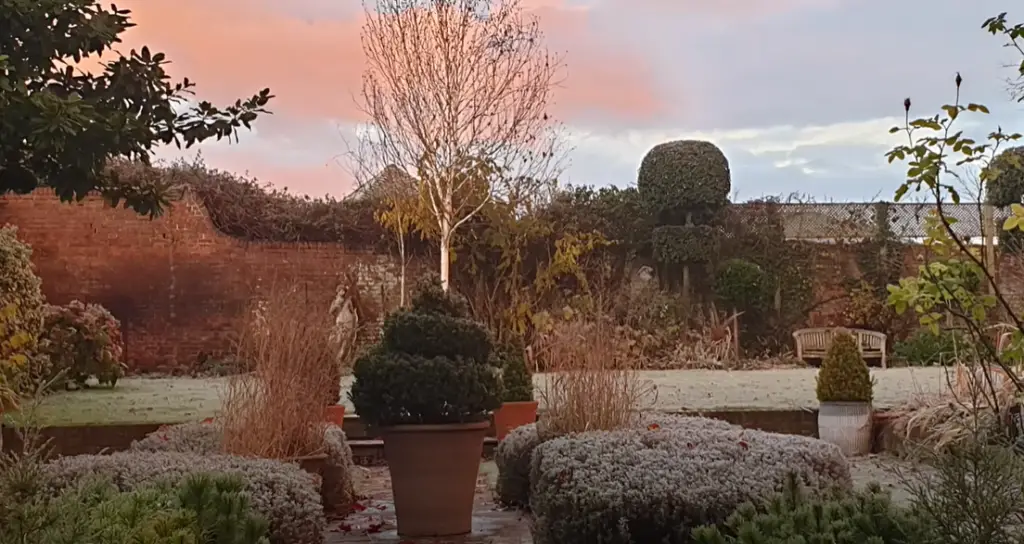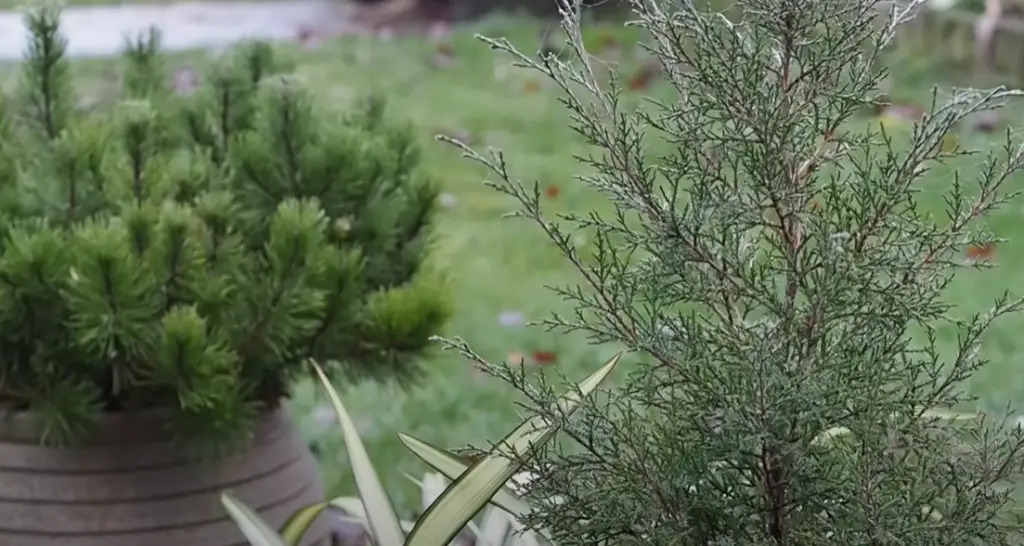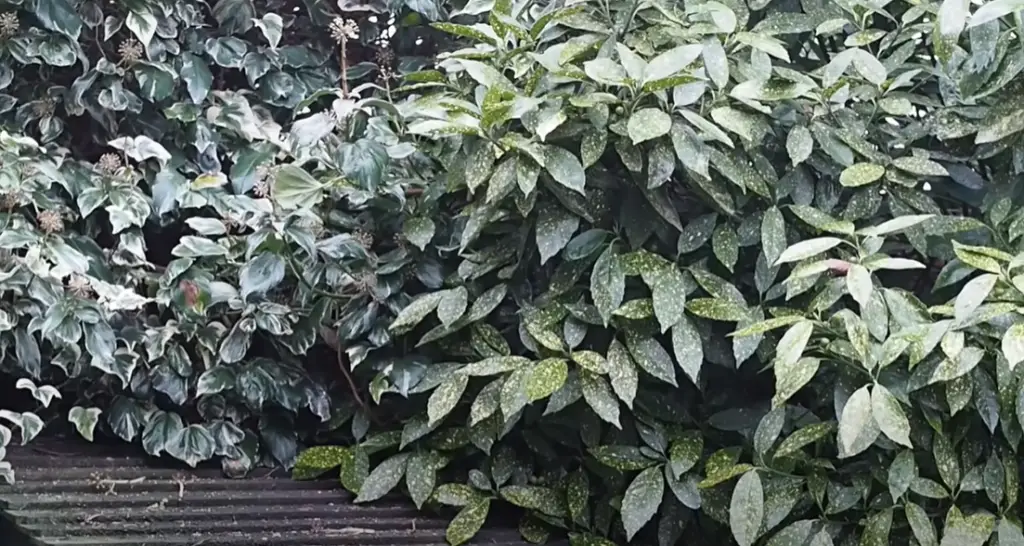Winter gardens are a popular way to add beauty and interest to your home. They can be used as a space for relaxation, entertaining, or simply enjoying the outdoors. The possibilities are endless when it comes to winter garden ideas! Whether you’re looking for ways to spruce up your outdoor space during the colder months or just wanting some unique design ideas to make your garden stand out, this article has you covered. We’ll answer some of the most commonly asked questions about winter gardens, provide useful tips and tricks for making the most of your space, and give examples of great winter garden ideas that will inspire you to create something beautiful.
Create a Structure With Beautiful, Bare Branches
Bare branches are a great way to give your winter garden an interesting and dramatic look. By strategically placing them throughout the space, you can create a unique structure that will provide visual interest. You can have fun with different colors and textures– try mixing in some evergreen plants for added color as well. Just be sure not to overcrowd the area, as this can make it look cluttered and unappealing. [1]
Use Hedging As A Backdrop To Winter Garden Planting
Hedging plants are invaluable for creating a backdrop to winter gardens. They provide stability, structure and shelter during tough weather conditions and can be used to create attention-grabbing visual effects. Whether you choose traditional or modern hedges, consider where the sun will fall at different times of day as well as size, shape and aspects that are suited to your garden.
Planting evergreen hedging plants like Yew, Box or Buxus sempervirens provides a great shelter during winter months and will look stunning in any garden layout. If you’re looking for something with more color, why not consider flowering varieties such as Euonymus ‘Emerald ‘n’ Gold,’ or Viburnum tinus which has large fragrant, white blooms. [1]
Man-Made Structures Can Create Focal Points
Man-made structures, such as benches and arbors, can be used to create focal points within your winter garden. These elements can draw the eye in towards a particular area or plant groupings. It’s important to remember that these features should enhance rather than detract from the natural beauty of your garden. Consider constructing small bridges over streams and ponds, adding decorative birdbaths, or even placing small garden benches in quiet corners for a peaceful escape. [1]

Choose Winter Plants For Bold Color
Winter gardens can be just as attractive and colorful as their summer counterparts! One of the best ways to create a vibrant winter garden is to select plants that offer bold colors. Some common choices include: pansies, ornamental kale, violas, dianthus, hellebores, and cyclamen. These plants come in many different varieties, so you can choose the colors that best suit your garden. Planting a combination of these plants will create stunning visual effects throughout the winter months.
In addition to vibrant colors, there is also an array of multi-colored foliage plants that work great in winter gardens. A few examples include: bergenia, heuchera, lamium, euonymus, and Mahonia. These plants have interesting foliage colors that range from metallic silver to vibrant purples, oranges, and yellows. Again, you can mix and match these types of plants to create a unique combination of colors in your winter garden. [1]
Plant For Fragrance
Fragrant plants can turn a winter garden into an aromatic wonderland! If you’re looking to create a cozy atmosphere, consider planting blooming shrubs like sweetbox (Sarcococca spp.), wintersweet (Chimonanthus praecox) and viburnum (Viburnum spp.) that will fill the air with their sweet scent. For an extra touch, try planting chocolate-scented evergreen shrub (Calycanthus floridus) or fragrant bush honeysuckle (Diervilla sessilifolia). [1]
Create Architectural Interest With Ornamental Grasses
Ornamental grasses are an excellent way to add architectural interest and movement to your winter garden. Look for varieties that maintain their structure, such as Calamagrostis x acutiflora ‘Karl Foerster’, Panicum virgatum ‘Heavy Metal’ or Miscanthus sinensis ‘Little Kitten’ for a low-care ornamental grass. Plant these in groups to create a strong visual impact while also providing wildlife habitat and helping reduce soil erosion. The unique shapes and sizes of the ornamental grasses will help create interest in your winter garden, even when other plants are dormant. In addition, many varieties produce attractive seed heads that persist through the cold months, adding additional structure and interest. [1]
Plant Evergreens That Bloom In Winter
If you want to add some color and life to your garden during the cold winter months, consider adding evergreens that flower in winter such as witch hazel and forsythia. These plants are able to withstand low temperatures and will offer a burst of color when other plants have stopped blooming. You can also plant camellia or holly for the winter season, both of which will provide a burst of vibrant red or yellow blooms. [1]
Plant Out Winter Favorites
For a winter garden that pops, fill it with your favorite plants. For example, if you love rose bushes, pick out some varieties that are hardy and will bloom in the cold season. Other favorites to consider include pansies, cyclamen, Christmas cactus and hellebores. These provide plenty of color and texture while they are in bloom and they look wonderful when they are not.
It is important to select plants that will thrive in the climate where you live. Many of these can be purchased already hardy enough for cooler temperatures, but there are also some plants that need a bit more protection if you live in an area with harsher winter conditions.[1]

Pick Plants For Wildlife, Even In Winter
You can still enjoy the outdoors, even in winter. Planting a variety of plants that attract different kinds of wildlife is one way to do this and will make your garden look beautiful as well. Some examples include planting berry-producing shrubs such as dogwood, viburnums, or cotoneaster; evergreens such as spruces, hemlocks, or junipers; and trees such as oaks, maples, and cherry. These will provide food for birds and other animals throughout the season. It’s also important to provide water sources like birdbaths or shallow containers filled with stones so that wildlife can stay hydrated even in cold temperatures. [1]
Grow Your Own Winter Garden Veg
What better way to enjoy seasonal produce than to grow your own winter garden veg? Growing vegetables in the cold weather is not only a great way to get your daily dose of vitamin-rich food, but it also allows you to make use of the colder months when outdoor growing may be difficult.
To create a successful winter vegetable garden, start by selecting vegetables that thrive in the lower temperatures of winter. This can include root vegetables like carrots and parsnips, as well as brassicas like broccoli and kale. Other cold-tolerant veggies to consider include beets, garlic, onions, peas, spinach, turnips and radishes. [1]
Topiary Looks Its Best In A Winter Garden
Topiary is the art of pruning trees, shrubs and hedges into geometric shapes or intricate figures. It’s a timeless feature that can give your winter garden an elegant and sophisticated feel. Topiary needs to be pruned regularly in order to keep its shape, but it looks especially good in the depths of winter when there are few other plants around. [1]
Go Overboard With Winter-Flowering Bulbs
Winter-flowering bulbs are a great way to spruce up your garden during the colder months. Tulips, daffodils, and crocus are among the most popular varieties of winter bulbs, but there are lots of other choices too! Planting these in clumps or even in drifts across your garden can create a stunning display. Make sure to plant your bulbs at least eight inches deep and six inches apart for the best results. Remember to water them regularly during dry spells and mulch around them for extra insulation in icy conditions. With a bit of care, you can enjoy beautiful blooms throughout winter! [1]

Group Winter Flowering Plants For Added Impact
Planting a winter garden is an excellent way to add color and vibrancy to your outdoor space. Grouping plants together can also help create a more impactful display, especially when you are planting winter flowering varieties. Placing certain types of plants close together helps them thrive due to sharing the same environment and soil requirements. It also creates a more dramatic impact and is visually pleasing.
When grouping plants, choose ones that are of similar heights so they appear balanced and complementary to one another. This will also help create a cohesive look in your garden space. Consider varieties like Pansies, Primroses, Heathers and Cyclamen as they all have stunning blooms in winter. You can also mix and match winter foliage plants such as Mahonia, Skimmia and Hebe for an attractive display. [1]
Put Up A Pergola For Evergreen Climbers
Pergolas are a great way to bring structure and beauty to any garden. During the winter, you can use them to provide support for evergreen climbers like honeysuckle, wisteria, and jasmine which will flower year-round. You can also put plants such as ivy or climbing roses under the pergola for added beauty and warmth. This will ensure that your garden stays alive and vibrant during the long winter months. Planting evergreen climbers alongside your pergola can add a touch of color to an otherwise dull landscape. It will also give you a great place to sit and relax in the summertime, when the vines are in full bloom! [1]
Pick Garden Furniture That Looks Good Year-Round
When selecting winter garden furniture, it’s important to choose pieces that will look good year-round. Get creative and pick materials and colors that keep your outdoor space looking vibrant even during the coldest months. Wicker chairs, wooden benches, or a metal bistro set are all options for furnishing your winter garden. You can even choose furniture that has a festive look, with warm winter-inspired colors. If you’re feeling extra creative, make your own furniture out of wood or other materials – just make sure to treat it so it’s weatherproof! [1]
Consider A Sheltered Space You Can Use Year Round
When it comes to winter garden ideas, one of the most popular options is to create a sheltered space where you can enjoy spending time outdoors throughout the year. Maybe you could invest in an outdoor gazebo or pergola that will provide some protection from wind and rain. Or perhaps you have a covered porch that can be used as a winter garden. Either way, the idea is to create an outdoor space that can be used all year round.
You don’t necessarily need to invest in a structure though – you could simply use movable furniture like umbrellas and planters to provide some protection from the elements while still creating a beautiful outdoor area. You can also use natural elements like trees, shrubs and hedges to create a cozy winter garden. [1]
Invest In A Chiminea
A chiminea can be a great addition to your winter garden! Not only will it add a cozy look and feel, but also provide plenty of warmth on cold winter nights. This traditional clay-pot style fireplace is an ideal way to keep your outdoor space inviting while providing sufficient heat for gathering with friends and family during the colder months. You can find many varieties of chimineas that range from a more classic style to modern, contemporary designs. Be sure to choose one that best suits your garden’s overall look, and invest in the right fuel and firelighters to ensure safe use. [1]

Hang A Bird Feeder
A great way to bring more wildlife into your winter garden is by installing a bird feeder. It’s not just enjoyable to watch the birds come in and out of your yard, but it also helps them survive the cold winter months. Make sure to choose an appropriate location for the feeder and keep it stocked with high-quality seed mixes suitable for the local bird population. If you want to attract even more birds, consider adding some birdhouses or other nesting boxes to your yard. You’ll be amazed at how quickly they take up residence! [1]
Invest In Garden Sculptures And Statues
Garden sculptures and statues are a great addition to any outdoor space. They can add some unique personality to your garden, creating an interesting focal point that encourages conversations with guests. Furthermore, garden sculptures and statues come in all shapes and sizes to fit any budget – from small birdbaths or wind chimes to larger stone figures or water features. When it comes to winter garden ideas, sculptures and statues can be a great way to bring color and life into an otherwise drab outdoor space. Whether you opt for something abstract or realistic, garden sculptures and statues can really bring your winter garden to life. [1]
Include House Plants In Your Winter Garden Display
House plants provide a perfect way to spruce up your winter garden during the months when outdoor plants are not in bloom. Not only can they add color and texture, but they also help purify the air indoors. Place different types of house plants around your patio or deck to give an instant lift to the overall look of your garden display.
If you’re looking for a low-maintenance option, consider succulents. They thrive in warmer climates, and they require minimal watering. Cacti also do well indoors during the winter months, since they are drought-tolerant and can usually get by with just a bit of water every month or two. [1]
FAQ
What grows best in a winter garden?
Vegetables and herbs are some of the staples you can grow in your winter garden. Popular choices include kale, spinach, lettuce, arugula, carrots, beets, garlic, onions and chard. Herbs such as thyme, oregano, rosemary, mint and parsley also thrive in colder climates.

What is the point of a winter garden?
A winter garden provides a source of fresh and healthy foods during the cold months. It also helps to keep your family fed throughout the season, so you don’t have to worry about produce shortages or price spikes. By creating a winter garden, you can reduce your reliance on expensive supermarket goods and help cut down on packaging waste too.
Is there such a thing as a winter garden?
Yes! A winter garden can be whatever you make it. You could create a traditional vegetable patch, or opt for an ornamental design with seasonal plants and trees. It’s important to take into account the regional climate when planning your winter garden, as this will affect what grows best.
What food grows in winter?
Thanks to careful planning, you can grow a range of different vegetables and herbs in your winter garden. Popular choices include kale, spinach, lettuce, arugula, carrots, beets, garlic, onions and chard. There are also plenty of fruits that can thrive in cold weather such as apples, pears and citrus.
Which fruit grows in winter?
Fruits such as apples, pears and citrus are all suitable for a winter garden. If you live in a colder climate, you can also try hardier varieties of plums, strawberries and raspberries. To ensure the best harvest, it’s important to choose plants that are suited to your regional climate.
What is the king of fruit in winter?
The king of winter fruits is undoubtedly the apple! Apples are a great source of vitamins and minerals, and they are perfect for making delicious pies and tarts. For best results, choose varieties that are suited to your regional climate.
Which fruits to avoid in the winter season?
In colder climates, it’s best to avoid delicate fruits such as peaches and apricots. These are better suited for warmer months. It’s also wise to avoid planting crops that take a long time to mature, as these may not have enough time before the weather turns cold again.
What are winter vegetables?
Winter vegetables are those that thrive in colder climates. Popular choices include kale, spinach, lettuce, arugula, carrots, beets, garlic and onions. Herbs such as thyme, oregano, rosemary and parsley are also perfect for a winter garden.
Useful Video: 180 Winter Garden SuNrOOm Design Ideas
Conclusion
Winter gardening is a great way to bring life and beauty to your home through the winter months. It can be as simple or complex as you would like — with just a few plants, some decoration, and lots of love, you can create an amazing winter garden! Whether you’re looking for ideas to brighten up your porch or create an indoor oasis, there are plenty of ways to make your winter garden stand out. With the right tips, you’ll be able to enjoy your outdoor space all season long! Don’t forget to stay safe and warm when doing any gardening in colder weather! We wish you luck on creating a beautiful winter garden!
References:
- https://www.homesandgardens.com/ideas/winter-garden-ideas










Leave a Reply
View Comments